Global Supply Chain Management: Tesco's Challenges and Strategies-2019
VerifiedAdded on 2023/04/23
|21
|6201
|375
Report
AI Summary
This report provides a comprehensive analysis of Tesco's global supply chain management, focusing on the contemporary problems and challenges the organization faces in operating its global supply chain and logistics network. It examines issues such as limited online potential, high delivery costs, trade-off choices, and competition. The report also discusses current global Supply Chain Management theories and best practices, including agency theory, network theory, and social exchange theory. Furthermore, it outlines practical supply chain management practices, such as establishing relationships with main suppliers, adopting green initiatives, leveraging technology, and fostering internal and external collaboration. Finally, the report proposes strategies to manage supply chain challenges related to inventory, labor, time, and error margins, including adopting automation and optimizing business procedures. The report also reflects on the organization’s different ranges of relationships, both internally and externally with suppliers, partners, and outsourcing providers.
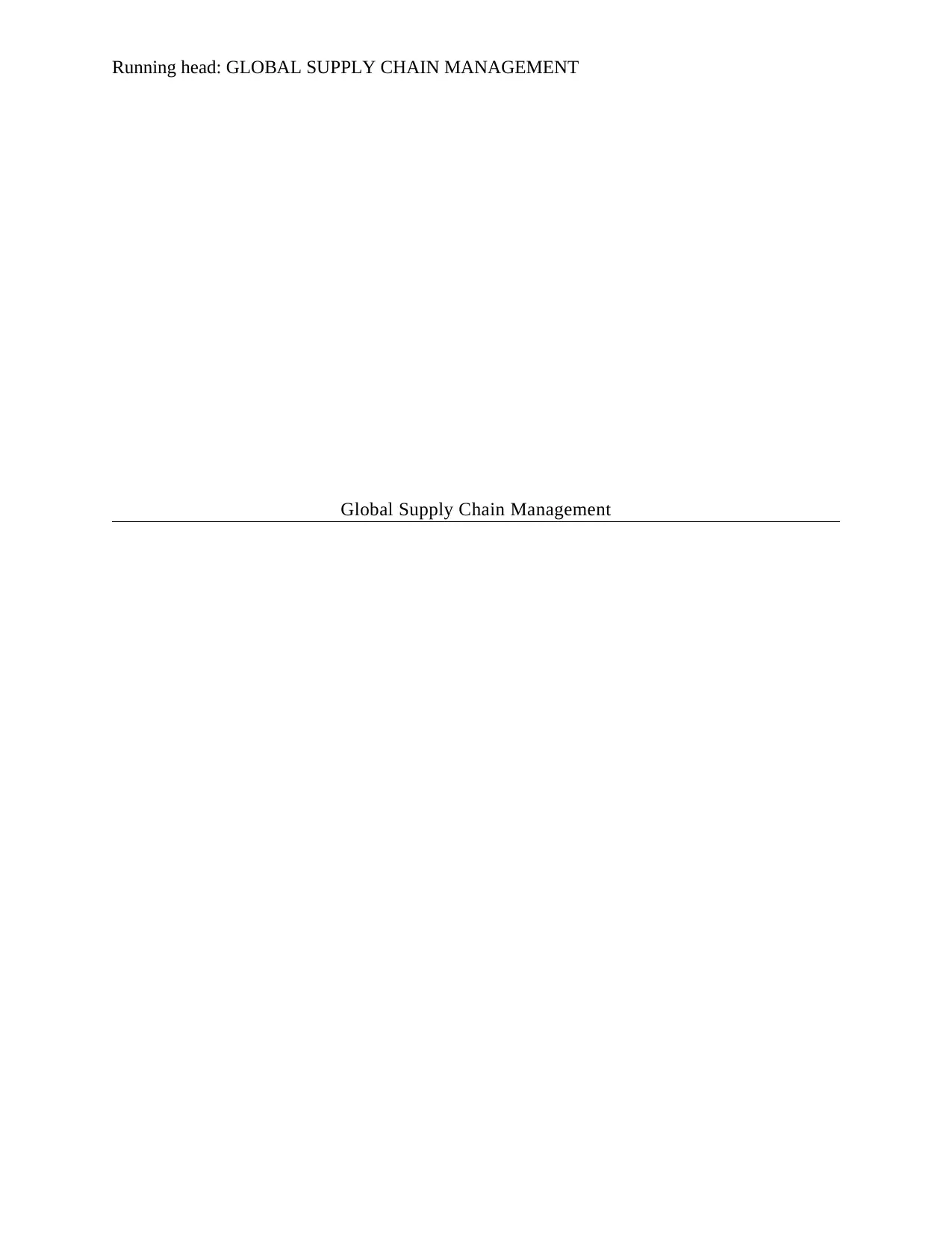
Running head: GLOBAL SUPPLY CHAIN MANAGEMENT
Global Supply Chain Management
Global Supply Chain Management
Paraphrase This Document
Need a fresh take? Get an instant paraphrase of this document with our AI Paraphraser
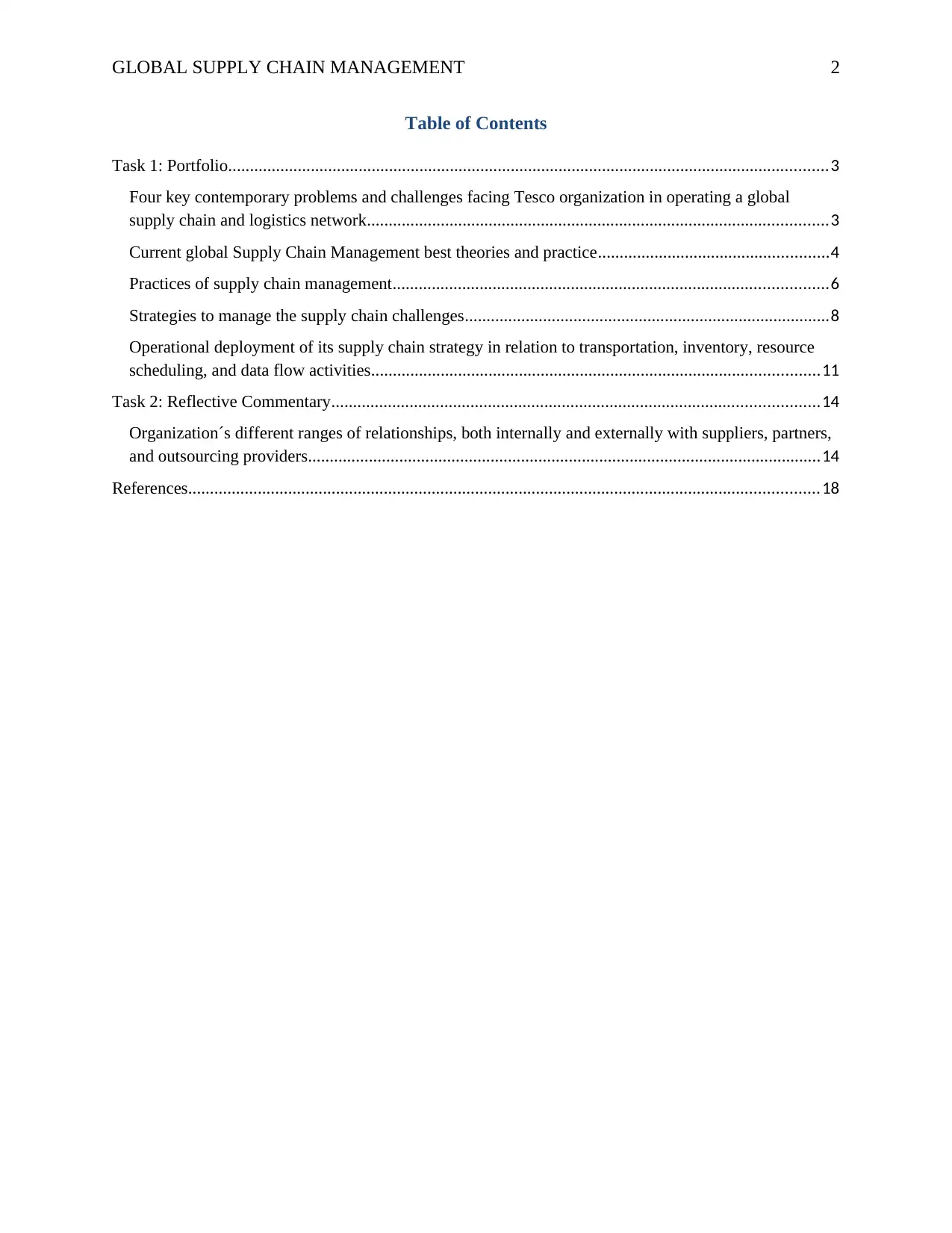
GLOBAL SUPPLY CHAIN MANAGEMENT 2
Table of Contents
Task 1: Portfolio..........................................................................................................................................3
Four key contemporary problems and challenges facing Tesco organization in operating a global
supply chain and logistics network..........................................................................................................3
Current global Supply Chain Management best theories and practice.....................................................4
Practices of supply chain management....................................................................................................6
Strategies to manage the supply chain challenges....................................................................................8
Operational deployment of its supply chain strategy in relation to transportation, inventory, resource
scheduling, and data flow activities.......................................................................................................11
Task 2: Reflective Commentary................................................................................................................14
Organization´s different ranges of relationships, both internally and externally with suppliers, partners,
and outsourcing providers......................................................................................................................14
References.................................................................................................................................................18
Table of Contents
Task 1: Portfolio..........................................................................................................................................3
Four key contemporary problems and challenges facing Tesco organization in operating a global
supply chain and logistics network..........................................................................................................3
Current global Supply Chain Management best theories and practice.....................................................4
Practices of supply chain management....................................................................................................6
Strategies to manage the supply chain challenges....................................................................................8
Operational deployment of its supply chain strategy in relation to transportation, inventory, resource
scheduling, and data flow activities.......................................................................................................11
Task 2: Reflective Commentary................................................................................................................14
Organization´s different ranges of relationships, both internally and externally with suppliers, partners,
and outsourcing providers......................................................................................................................14
References.................................................................................................................................................18
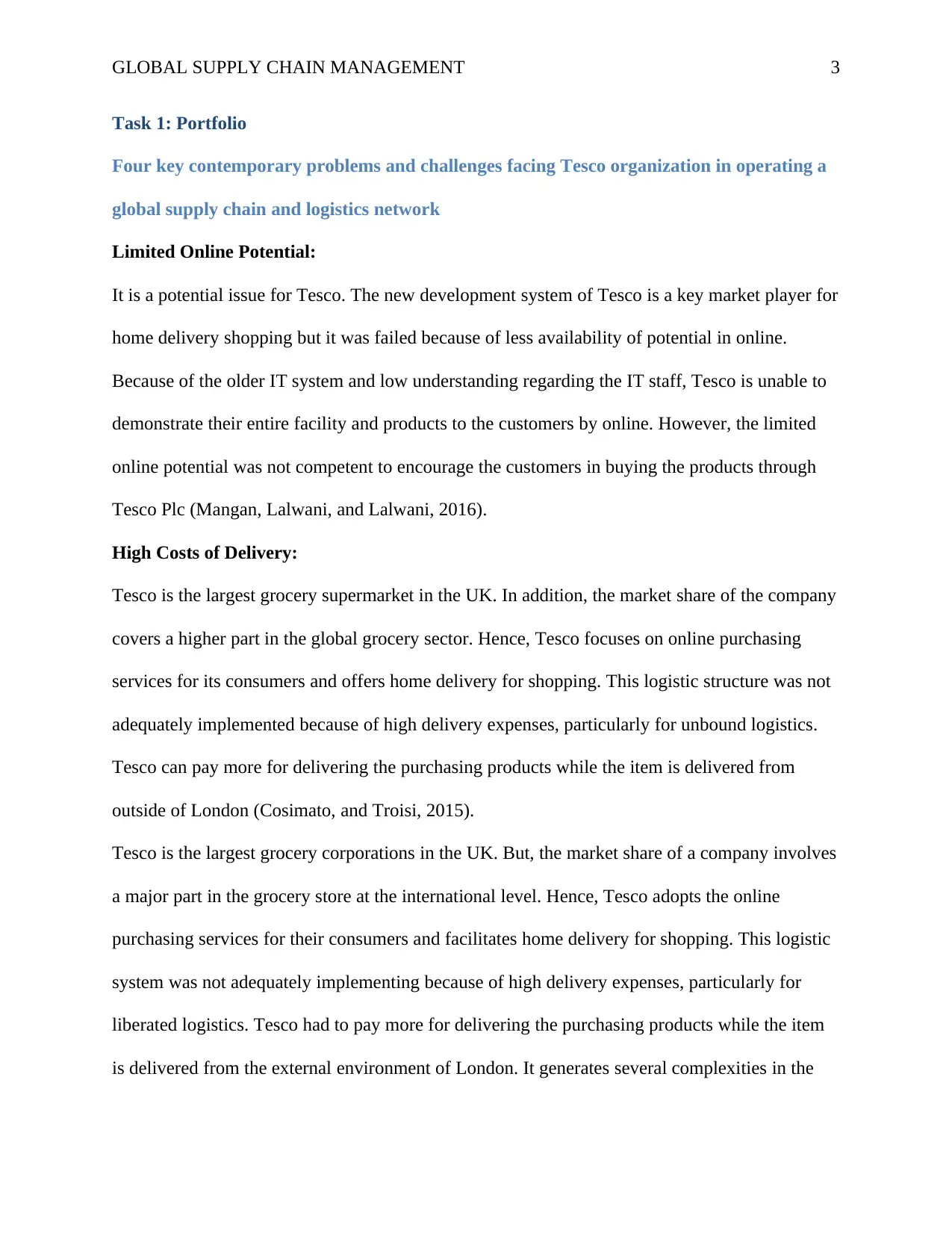
GLOBAL SUPPLY CHAIN MANAGEMENT 3
Task 1: Portfolio
Four key contemporary problems and challenges facing Tesco organization in operating a
global supply chain and logistics network
Limited Online Potential:
It is a potential issue for Tesco. The new development system of Tesco is a key market player for
home delivery shopping but it was failed because of less availability of potential in online.
Because of the older IT system and low understanding regarding the IT staff, Tesco is unable to
demonstrate their entire facility and products to the customers by online. However, the limited
online potential was not competent to encourage the customers in buying the products through
Tesco Plc (Mangan, Lalwani, and Lalwani, 2016).
High Costs of Delivery:
Tesco is the largest grocery supermarket in the UK. In addition, the market share of the company
covers a higher part in the global grocery sector. Hence, Tesco focuses on online purchasing
services for its consumers and offers home delivery for shopping. This logistic structure was not
adequately implemented because of high delivery expenses, particularly for unbound logistics.
Tesco can pay more for delivering the purchasing products while the item is delivered from
outside of London (Cosimato, and Troisi, 2015).
Tesco is the largest grocery corporations in the UK. But, the market share of a company involves
a major part in the grocery store at the international level. Hence, Tesco adopts the online
purchasing services for their consumers and facilitates home delivery for shopping. This logistic
system was not adequately implementing because of high delivery expenses, particularly for
liberated logistics. Tesco had to pay more for delivering the purchasing products while the item
is delivered from the external environment of London. It generates several complexities in the
Task 1: Portfolio
Four key contemporary problems and challenges facing Tesco organization in operating a
global supply chain and logistics network
Limited Online Potential:
It is a potential issue for Tesco. The new development system of Tesco is a key market player for
home delivery shopping but it was failed because of less availability of potential in online.
Because of the older IT system and low understanding regarding the IT staff, Tesco is unable to
demonstrate their entire facility and products to the customers by online. However, the limited
online potential was not competent to encourage the customers in buying the products through
Tesco Plc (Mangan, Lalwani, and Lalwani, 2016).
High Costs of Delivery:
Tesco is the largest grocery supermarket in the UK. In addition, the market share of the company
covers a higher part in the global grocery sector. Hence, Tesco focuses on online purchasing
services for its consumers and offers home delivery for shopping. This logistic structure was not
adequately implemented because of high delivery expenses, particularly for unbound logistics.
Tesco can pay more for delivering the purchasing products while the item is delivered from
outside of London (Cosimato, and Troisi, 2015).
Tesco is the largest grocery corporations in the UK. But, the market share of a company involves
a major part in the grocery store at the international level. Hence, Tesco adopts the online
purchasing services for their consumers and facilitates home delivery for shopping. This logistic
system was not adequately implementing because of high delivery expenses, particularly for
liberated logistics. Tesco had to pay more for delivering the purchasing products while the item
is delivered from the external environment of London. It generates several complexities in the
⊘ This is a preview!⊘
Do you want full access?
Subscribe today to unlock all pages.

Trusted by 1+ million students worldwide
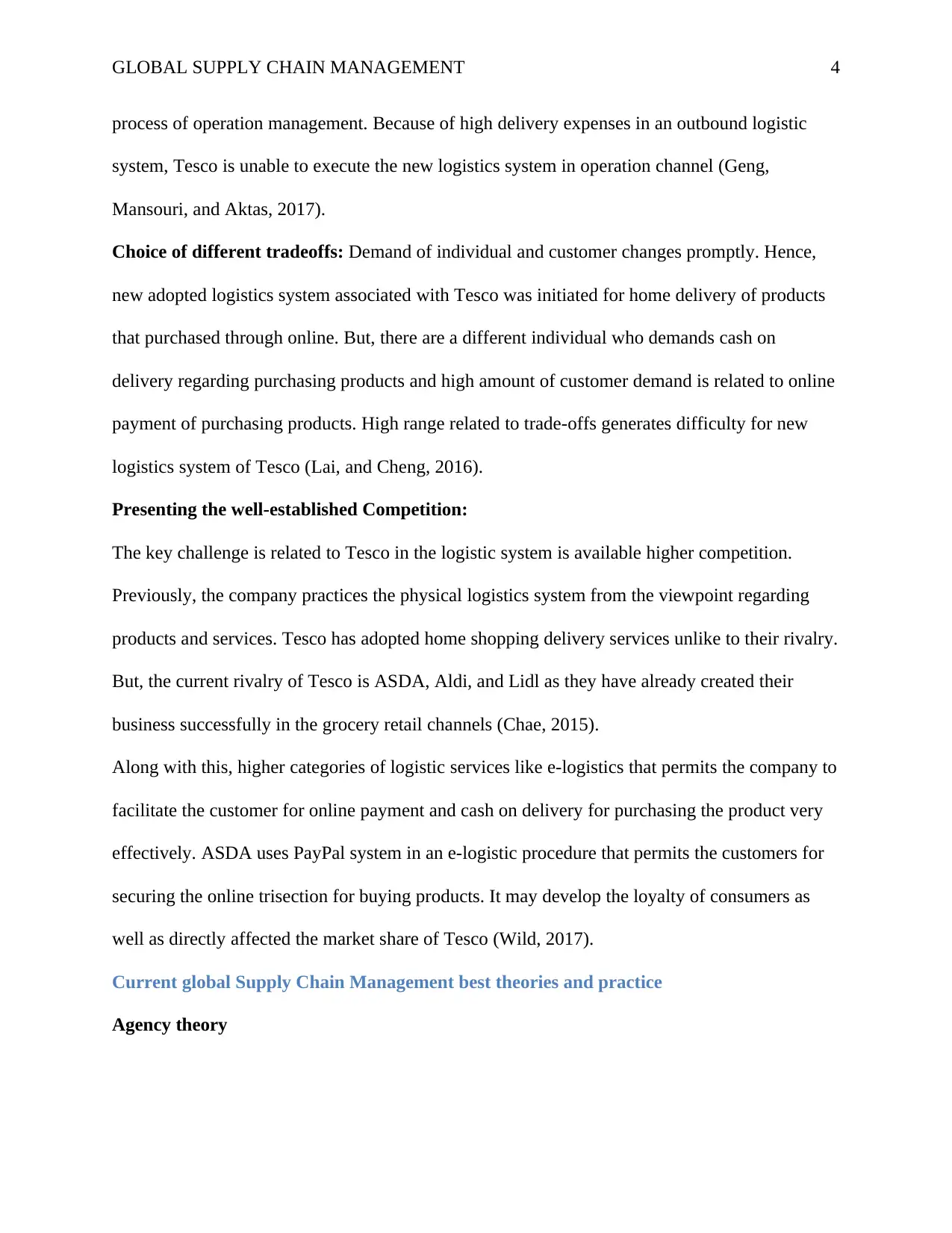
GLOBAL SUPPLY CHAIN MANAGEMENT 4
process of operation management. Because of high delivery expenses in an outbound logistic
system, Tesco is unable to execute the new logistics system in operation channel (Geng,
Mansouri, and Aktas, 2017).
Choice of different tradeoffs: Demand of individual and customer changes promptly. Hence,
new adopted logistics system associated with Tesco was initiated for home delivery of products
that purchased through online. But, there are a different individual who demands cash on
delivery regarding purchasing products and high amount of customer demand is related to online
payment of purchasing products. High range related to trade-offs generates difficulty for new
logistics system of Tesco (Lai, and Cheng, 2016).
Presenting the well-established Competition:
The key challenge is related to Tesco in the logistic system is available higher competition.
Previously, the company practices the physical logistics system from the viewpoint regarding
products and services. Tesco has adopted home shopping delivery services unlike to their rivalry.
But, the current rivalry of Tesco is ASDA, Aldi, and Lidl as they have already created their
business successfully in the grocery retail channels (Chae, 2015).
Along with this, higher categories of logistic services like e-logistics that permits the company to
facilitate the customer for online payment and cash on delivery for purchasing the product very
effectively. ASDA uses PayPal system in an e-logistic procedure that permits the customers for
securing the online trisection for buying products. It may develop the loyalty of consumers as
well as directly affected the market share of Tesco (Wild, 2017).
Current global Supply Chain Management best theories and practice
Agency theory
process of operation management. Because of high delivery expenses in an outbound logistic
system, Tesco is unable to execute the new logistics system in operation channel (Geng,
Mansouri, and Aktas, 2017).
Choice of different tradeoffs: Demand of individual and customer changes promptly. Hence,
new adopted logistics system associated with Tesco was initiated for home delivery of products
that purchased through online. But, there are a different individual who demands cash on
delivery regarding purchasing products and high amount of customer demand is related to online
payment of purchasing products. High range related to trade-offs generates difficulty for new
logistics system of Tesco (Lai, and Cheng, 2016).
Presenting the well-established Competition:
The key challenge is related to Tesco in the logistic system is available higher competition.
Previously, the company practices the physical logistics system from the viewpoint regarding
products and services. Tesco has adopted home shopping delivery services unlike to their rivalry.
But, the current rivalry of Tesco is ASDA, Aldi, and Lidl as they have already created their
business successfully in the grocery retail channels (Chae, 2015).
Along with this, higher categories of logistic services like e-logistics that permits the company to
facilitate the customer for online payment and cash on delivery for purchasing the product very
effectively. ASDA uses PayPal system in an e-logistic procedure that permits the customers for
securing the online trisection for buying products. It may develop the loyalty of consumers as
well as directly affected the market share of Tesco (Wild, 2017).
Current global Supply Chain Management best theories and practice
Agency theory
Paraphrase This Document
Need a fresh take? Get an instant paraphrase of this document with our AI Paraphraser

GLOBAL SUPPLY CHAIN MANAGEMENT 5
Under supply management, the agency theory defines that the retail chain is a series of
agreement among shareholders. This agency relationship creates when a set of owners is known
as principals and hires another group that is called agent for day to day operation of supply
outlets. There are some services, which delegates to new decision-making authority. Along with
this, agency relationships show the relationship in supply chain management such as the
association between buyers and suppliers as well as between management and suppliers
(Christopher, 2016). The distinguishing feature of the theory is to separate the ownership
regarding the supply chain of a company from the control of the supply chain. The ownership of
the supply chain is focused by shareholders of the company as well as controlling the day to day
operation is in hand of professional managers, which is illustrated as the agents. Along with this,
the agent can take action whose results are largely performed by shareholders of the company.
Shareholders also focus on ratification, monitoring and sanctioning in the way of compensation
as well as involves the discipline measure (Yu, et. al., 2017).
Network theory in global supply chain management
The network theory is one of theory used in purchasing and supply management that can be
introduced at the time of last decades. Along with this, network theory can be involved to assess
the association in which customers, suppliers, and buyers are engaged. In addition, this strategy
involves the collaboration between other parties in the network to serve the demand. It can be
generated from the market and industry where they are operating in (Wang, et. al., 2016).
Along with this, when the purchasing department in one company focuses on no opportunity to
develop the particular item in-house as well as the outsourcing and purchasing procedure of these
items can be favored by network strategy. This theory supports to understand the demand
Under supply management, the agency theory defines that the retail chain is a series of
agreement among shareholders. This agency relationship creates when a set of owners is known
as principals and hires another group that is called agent for day to day operation of supply
outlets. There are some services, which delegates to new decision-making authority. Along with
this, agency relationships show the relationship in supply chain management such as the
association between buyers and suppliers as well as between management and suppliers
(Christopher, 2016). The distinguishing feature of the theory is to separate the ownership
regarding the supply chain of a company from the control of the supply chain. The ownership of
the supply chain is focused by shareholders of the company as well as controlling the day to day
operation is in hand of professional managers, which is illustrated as the agents. Along with this,
the agent can take action whose results are largely performed by shareholders of the company.
Shareholders also focus on ratification, monitoring and sanctioning in the way of compensation
as well as involves the discipline measure (Yu, et. al., 2017).
Network theory in global supply chain management
The network theory is one of theory used in purchasing and supply management that can be
introduced at the time of last decades. Along with this, network theory can be involved to assess
the association in which customers, suppliers, and buyers are engaged. In addition, this strategy
involves the collaboration between other parties in the network to serve the demand. It can be
generated from the market and industry where they are operating in (Wang, et. al., 2016).
Along with this, when the purchasing department in one company focuses on no opportunity to
develop the particular item in-house as well as the outsourcing and purchasing procedure of these
items can be favored by network strategy. This theory supports to understand the demand
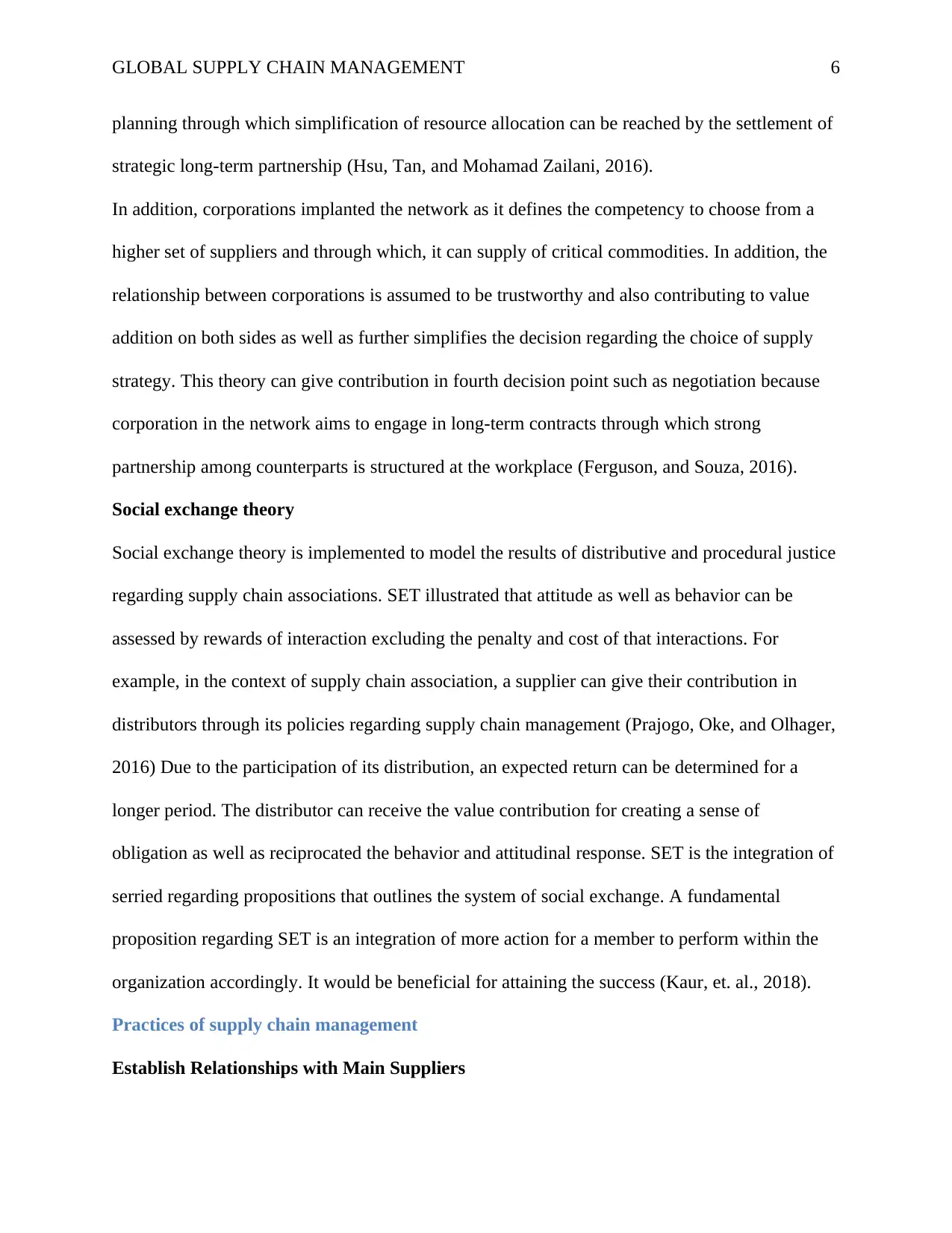
GLOBAL SUPPLY CHAIN MANAGEMENT 6
planning through which simplification of resource allocation can be reached by the settlement of
strategic long-term partnership (Hsu, Tan, and Mohamad Zailani, 2016).
In addition, corporations implanted the network as it defines the competency to choose from a
higher set of suppliers and through which, it can supply of critical commodities. In addition, the
relationship between corporations is assumed to be trustworthy and also contributing to value
addition on both sides as well as further simplifies the decision regarding the choice of supply
strategy. This theory can give contribution in fourth decision point such as negotiation because
corporation in the network aims to engage in long-term contracts through which strong
partnership among counterparts is structured at the workplace (Ferguson, and Souza, 2016).
Social exchange theory
Social exchange theory is implemented to model the results of distributive and procedural justice
regarding supply chain associations. SET illustrated that attitude as well as behavior can be
assessed by rewards of interaction excluding the penalty and cost of that interactions. For
example, in the context of supply chain association, a supplier can give their contribution in
distributors through its policies regarding supply chain management (Prajogo, Oke, and Olhager,
2016) Due to the participation of its distribution, an expected return can be determined for a
longer period. The distributor can receive the value contribution for creating a sense of
obligation as well as reciprocated the behavior and attitudinal response. SET is the integration of
serried regarding propositions that outlines the system of social exchange. A fundamental
proposition regarding SET is an integration of more action for a member to perform within the
organization accordingly. It would be beneficial for attaining the success (Kaur, et. al., 2018).
Practices of supply chain management
Establish Relationships with Main Suppliers
planning through which simplification of resource allocation can be reached by the settlement of
strategic long-term partnership (Hsu, Tan, and Mohamad Zailani, 2016).
In addition, corporations implanted the network as it defines the competency to choose from a
higher set of suppliers and through which, it can supply of critical commodities. In addition, the
relationship between corporations is assumed to be trustworthy and also contributing to value
addition on both sides as well as further simplifies the decision regarding the choice of supply
strategy. This theory can give contribution in fourth decision point such as negotiation because
corporation in the network aims to engage in long-term contracts through which strong
partnership among counterparts is structured at the workplace (Ferguson, and Souza, 2016).
Social exchange theory
Social exchange theory is implemented to model the results of distributive and procedural justice
regarding supply chain associations. SET illustrated that attitude as well as behavior can be
assessed by rewards of interaction excluding the penalty and cost of that interactions. For
example, in the context of supply chain association, a supplier can give their contribution in
distributors through its policies regarding supply chain management (Prajogo, Oke, and Olhager,
2016) Due to the participation of its distribution, an expected return can be determined for a
longer period. The distributor can receive the value contribution for creating a sense of
obligation as well as reciprocated the behavior and attitudinal response. SET is the integration of
serried regarding propositions that outlines the system of social exchange. A fundamental
proposition regarding SET is an integration of more action for a member to perform within the
organization accordingly. It would be beneficial for attaining the success (Kaur, et. al., 2018).
Practices of supply chain management
Establish Relationships with Main Suppliers
⊘ This is a preview!⊘
Do you want full access?
Subscribe today to unlock all pages.

Trusted by 1+ million students worldwide
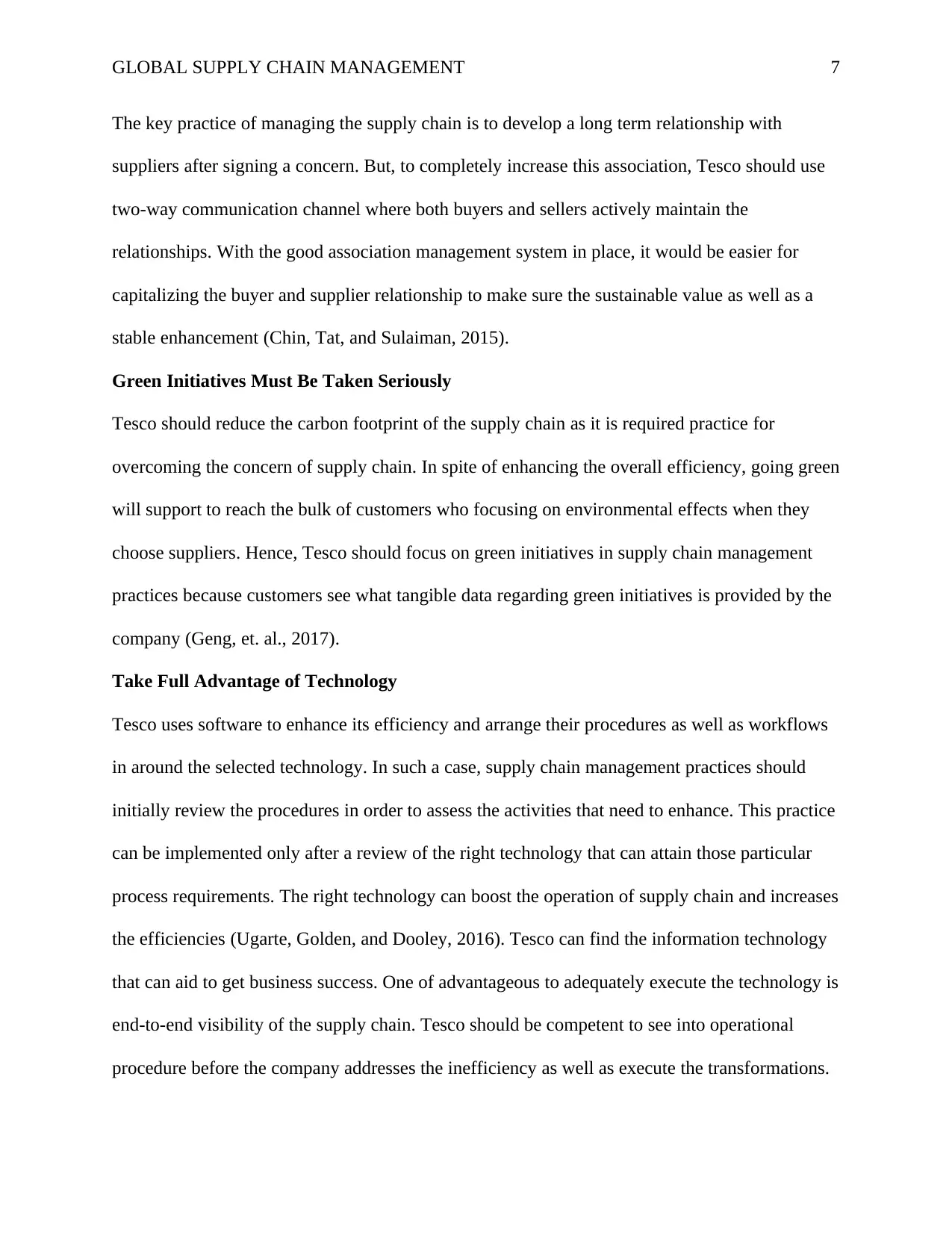
GLOBAL SUPPLY CHAIN MANAGEMENT 7
The key practice of managing the supply chain is to develop a long term relationship with
suppliers after signing a concern. But, to completely increase this association, Tesco should use
two-way communication channel where both buyers and sellers actively maintain the
relationships. With the good association management system in place, it would be easier for
capitalizing the buyer and supplier relationship to make sure the sustainable value as well as a
stable enhancement (Chin, Tat, and Sulaiman, 2015).
Green Initiatives Must Be Taken Seriously
Tesco should reduce the carbon footprint of the supply chain as it is required practice for
overcoming the concern of supply chain. In spite of enhancing the overall efficiency, going green
will support to reach the bulk of customers who focusing on environmental effects when they
choose suppliers. Hence, Tesco should focus on green initiatives in supply chain management
practices because customers see what tangible data regarding green initiatives is provided by the
company (Geng, et. al., 2017).
Take Full Advantage of Technology
Tesco uses software to enhance its efficiency and arrange their procedures as well as workflows
in around the selected technology. In such a case, supply chain management practices should
initially review the procedures in order to assess the activities that need to enhance. This practice
can be implemented only after a review of the right technology that can attain those particular
process requirements. The right technology can boost the operation of supply chain and increases
the efficiencies (Ugarte, Golden, and Dooley, 2016). Tesco can find the information technology
that can aid to get business success. One of advantageous to adequately execute the technology is
end-to-end visibility of the supply chain. Tesco should be competent to see into operational
procedure before the company addresses the inefficiency as well as execute the transformations.
The key practice of managing the supply chain is to develop a long term relationship with
suppliers after signing a concern. But, to completely increase this association, Tesco should use
two-way communication channel where both buyers and sellers actively maintain the
relationships. With the good association management system in place, it would be easier for
capitalizing the buyer and supplier relationship to make sure the sustainable value as well as a
stable enhancement (Chin, Tat, and Sulaiman, 2015).
Green Initiatives Must Be Taken Seriously
Tesco should reduce the carbon footprint of the supply chain as it is required practice for
overcoming the concern of supply chain. In spite of enhancing the overall efficiency, going green
will support to reach the bulk of customers who focusing on environmental effects when they
choose suppliers. Hence, Tesco should focus on green initiatives in supply chain management
practices because customers see what tangible data regarding green initiatives is provided by the
company (Geng, et. al., 2017).
Take Full Advantage of Technology
Tesco uses software to enhance its efficiency and arrange their procedures as well as workflows
in around the selected technology. In such a case, supply chain management practices should
initially review the procedures in order to assess the activities that need to enhance. This practice
can be implemented only after a review of the right technology that can attain those particular
process requirements. The right technology can boost the operation of supply chain and increases
the efficiencies (Ugarte, Golden, and Dooley, 2016). Tesco can find the information technology
that can aid to get business success. One of advantageous to adequately execute the technology is
end-to-end visibility of the supply chain. Tesco should be competent to see into operational
procedure before the company addresses the inefficiency as well as execute the transformations.
Paraphrase This Document
Need a fresh take? Get an instant paraphrase of this document with our AI Paraphraser

GLOBAL SUPPLY CHAIN MANAGEMENT 8
Once transparency of supply chain is attained, the decision could be made promptly as well as
surprise disruptions could be eliminated (Schönsleben, 2016).
Collaborate Internally and Externally:
At the internal level, each individual should be on the same page as well as focuses on the same
goal. The real-time communication would support to create the supply chain decisions promptly
and more feasible. It would also support for avoiding the disruptions of the supply chain. Along
with this, external collaboration is essential because sometimes, a trustworthy supply chain
partner proves invaluable. For example, Tesco shares technology and data when its supply chain
relies on others. Hence, it should execute the formal supplier management strategy to better
collaborate with the suppliers. In such a manner, it can get benefits (Grant, Trautrims, and Wong,
2017).
Strategies to manage the supply chain challenges
Inventory:
Customer may wish to purchase where they get flexibility and endless range of products. Hence,
Tesco should desire a single inventory pool for controlling the investment. The key challenge for
Tesco is related to in-store accuracy level, technology competencies, DC combined practices and
system-wide visibility (Grant, Trautrims, and Wong, 2017).
Labor:
The cost associated with employment and turnover concern can justify the new technique for DC
(Distribution Centre) operation. In order to deal with the issues, Tesco plc should assess return
on investment for automation opportunity. To attain such a goal, it can justify the major
investment as well as integrates the Omni-channel operations (Stadtler, 2015).
Time:
Once transparency of supply chain is attained, the decision could be made promptly as well as
surprise disruptions could be eliminated (Schönsleben, 2016).
Collaborate Internally and Externally:
At the internal level, each individual should be on the same page as well as focuses on the same
goal. The real-time communication would support to create the supply chain decisions promptly
and more feasible. It would also support for avoiding the disruptions of the supply chain. Along
with this, external collaboration is essential because sometimes, a trustworthy supply chain
partner proves invaluable. For example, Tesco shares technology and data when its supply chain
relies on others. Hence, it should execute the formal supplier management strategy to better
collaborate with the suppliers. In such a manner, it can get benefits (Grant, Trautrims, and Wong,
2017).
Strategies to manage the supply chain challenges
Inventory:
Customer may wish to purchase where they get flexibility and endless range of products. Hence,
Tesco should desire a single inventory pool for controlling the investment. The key challenge for
Tesco is related to in-store accuracy level, technology competencies, DC combined practices and
system-wide visibility (Grant, Trautrims, and Wong, 2017).
Labor:
The cost associated with employment and turnover concern can justify the new technique for DC
(Distribution Centre) operation. In order to deal with the issues, Tesco plc should assess return
on investment for automation opportunity. To attain such a goal, it can justify the major
investment as well as integrates the Omni-channel operations (Stadtler, 2015).
Time:
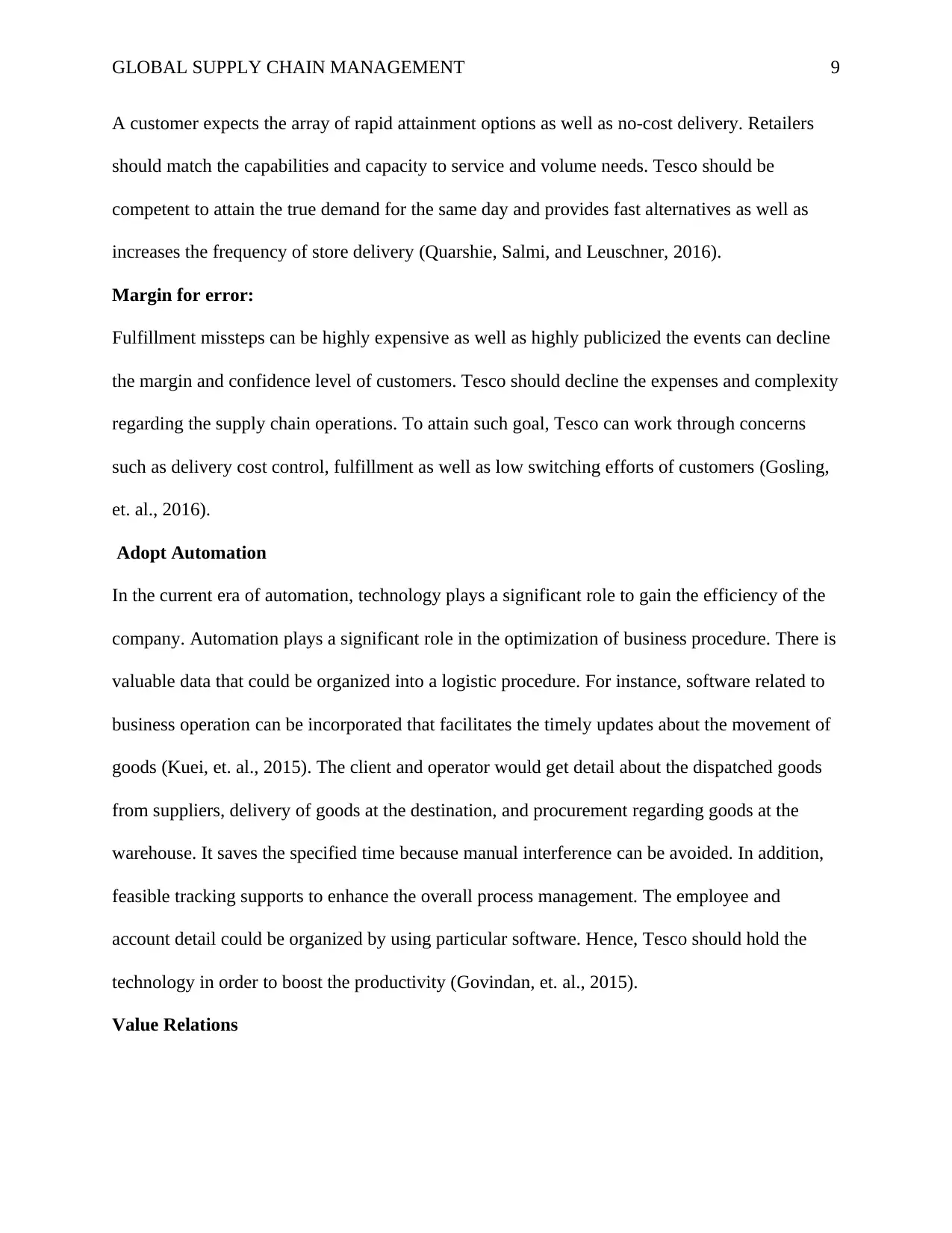
GLOBAL SUPPLY CHAIN MANAGEMENT 9
A customer expects the array of rapid attainment options as well as no-cost delivery. Retailers
should match the capabilities and capacity to service and volume needs. Tesco should be
competent to attain the true demand for the same day and provides fast alternatives as well as
increases the frequency of store delivery (Quarshie, Salmi, and Leuschner, 2016).
Margin for error:
Fulfillment missteps can be highly expensive as well as highly publicized the events can decline
the margin and confidence level of customers. Tesco should decline the expenses and complexity
regarding the supply chain operations. To attain such goal, Tesco can work through concerns
such as delivery cost control, fulfillment as well as low switching efforts of customers (Gosling,
et. al., 2016).
Adopt Automation
In the current era of automation, technology plays a significant role to gain the efficiency of the
company. Automation plays a significant role in the optimization of business procedure. There is
valuable data that could be organized into a logistic procedure. For instance, software related to
business operation can be incorporated that facilitates the timely updates about the movement of
goods (Kuei, et. al., 2015). The client and operator would get detail about the dispatched goods
from suppliers, delivery of goods at the destination, and procurement regarding goods at the
warehouse. It saves the specified time because manual interference can be avoided. In addition,
feasible tracking supports to enhance the overall process management. The employee and
account detail could be organized by using particular software. Hence, Tesco should hold the
technology in order to boost the productivity (Govindan, et. al., 2015).
Value Relations
A customer expects the array of rapid attainment options as well as no-cost delivery. Retailers
should match the capabilities and capacity to service and volume needs. Tesco should be
competent to attain the true demand for the same day and provides fast alternatives as well as
increases the frequency of store delivery (Quarshie, Salmi, and Leuschner, 2016).
Margin for error:
Fulfillment missteps can be highly expensive as well as highly publicized the events can decline
the margin and confidence level of customers. Tesco should decline the expenses and complexity
regarding the supply chain operations. To attain such goal, Tesco can work through concerns
such as delivery cost control, fulfillment as well as low switching efforts of customers (Gosling,
et. al., 2016).
Adopt Automation
In the current era of automation, technology plays a significant role to gain the efficiency of the
company. Automation plays a significant role in the optimization of business procedure. There is
valuable data that could be organized into a logistic procedure. For instance, software related to
business operation can be incorporated that facilitates the timely updates about the movement of
goods (Kuei, et. al., 2015). The client and operator would get detail about the dispatched goods
from suppliers, delivery of goods at the destination, and procurement regarding goods at the
warehouse. It saves the specified time because manual interference can be avoided. In addition,
feasible tracking supports to enhance the overall process management. The employee and
account detail could be organized by using particular software. Hence, Tesco should hold the
technology in order to boost the productivity (Govindan, et. al., 2015).
Value Relations
⊘ This is a preview!⊘
Do you want full access?
Subscribe today to unlock all pages.

Trusted by 1+ million students worldwide
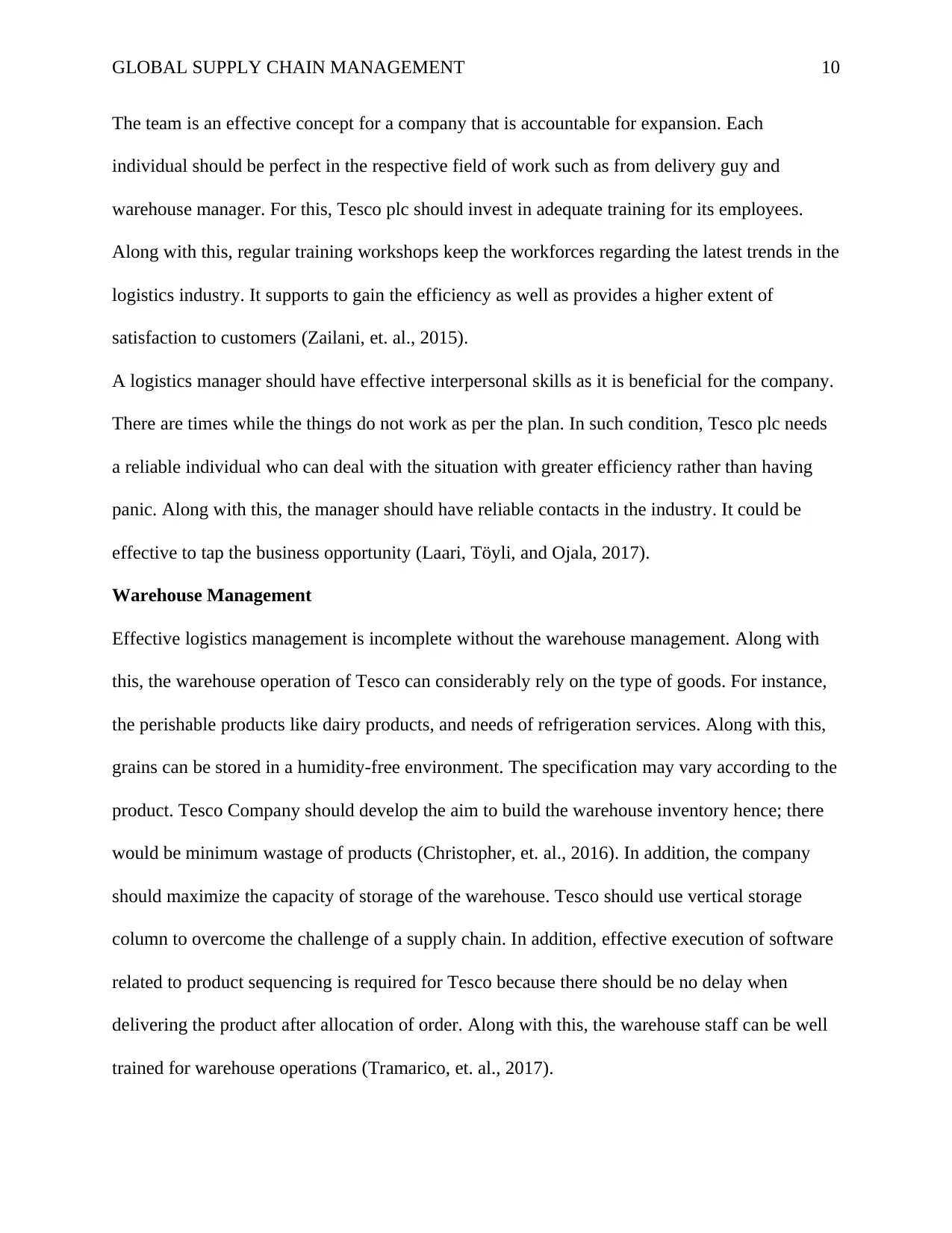
GLOBAL SUPPLY CHAIN MANAGEMENT 10
The team is an effective concept for a company that is accountable for expansion. Each
individual should be perfect in the respective field of work such as from delivery guy and
warehouse manager. For this, Tesco plc should invest in adequate training for its employees.
Along with this, regular training workshops keep the workforces regarding the latest trends in the
logistics industry. It supports to gain the efficiency as well as provides a higher extent of
satisfaction to customers (Zailani, et. al., 2015).
A logistics manager should have effective interpersonal skills as it is beneficial for the company.
There are times while the things do not work as per the plan. In such condition, Tesco plc needs
a reliable individual who can deal with the situation with greater efficiency rather than having
panic. Along with this, the manager should have reliable contacts in the industry. It could be
effective to tap the business opportunity (Laari, Töyli, and Ojala, 2017).
Warehouse Management
Effective logistics management is incomplete without the warehouse management. Along with
this, the warehouse operation of Tesco can considerably rely on the type of goods. For instance,
the perishable products like dairy products, and needs of refrigeration services. Along with this,
grains can be stored in a humidity-free environment. The specification may vary according to the
product. Tesco Company should develop the aim to build the warehouse inventory hence; there
would be minimum wastage of products (Christopher, et. al., 2016). In addition, the company
should maximize the capacity of storage of the warehouse. Tesco should use vertical storage
column to overcome the challenge of a supply chain. In addition, effective execution of software
related to product sequencing is required for Tesco because there should be no delay when
delivering the product after allocation of order. Along with this, the warehouse staff can be well
trained for warehouse operations (Tramarico, et. al., 2017).
The team is an effective concept for a company that is accountable for expansion. Each
individual should be perfect in the respective field of work such as from delivery guy and
warehouse manager. For this, Tesco plc should invest in adequate training for its employees.
Along with this, regular training workshops keep the workforces regarding the latest trends in the
logistics industry. It supports to gain the efficiency as well as provides a higher extent of
satisfaction to customers (Zailani, et. al., 2015).
A logistics manager should have effective interpersonal skills as it is beneficial for the company.
There are times while the things do not work as per the plan. In such condition, Tesco plc needs
a reliable individual who can deal with the situation with greater efficiency rather than having
panic. Along with this, the manager should have reliable contacts in the industry. It could be
effective to tap the business opportunity (Laari, Töyli, and Ojala, 2017).
Warehouse Management
Effective logistics management is incomplete without the warehouse management. Along with
this, the warehouse operation of Tesco can considerably rely on the type of goods. For instance,
the perishable products like dairy products, and needs of refrigeration services. Along with this,
grains can be stored in a humidity-free environment. The specification may vary according to the
product. Tesco Company should develop the aim to build the warehouse inventory hence; there
would be minimum wastage of products (Christopher, et. al., 2016). In addition, the company
should maximize the capacity of storage of the warehouse. Tesco should use vertical storage
column to overcome the challenge of a supply chain. In addition, effective execution of software
related to product sequencing is required for Tesco because there should be no delay when
delivering the product after allocation of order. Along with this, the warehouse staff can be well
trained for warehouse operations (Tramarico, et. al., 2017).
Paraphrase This Document
Need a fresh take? Get an instant paraphrase of this document with our AI Paraphraser
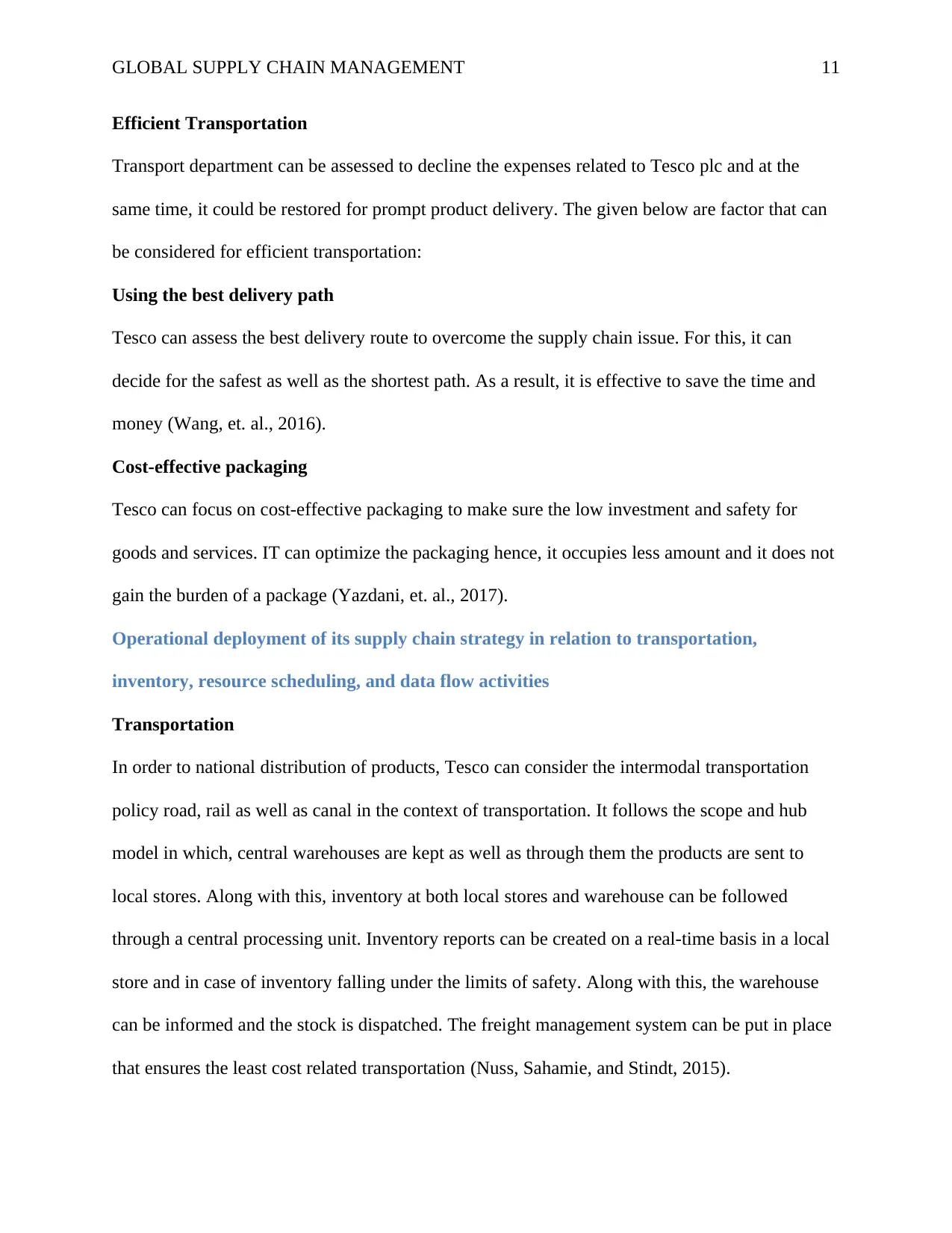
GLOBAL SUPPLY CHAIN MANAGEMENT 11
Efficient Transportation
Transport department can be assessed to decline the expenses related to Tesco plc and at the
same time, it could be restored for prompt product delivery. The given below are factor that can
be considered for efficient transportation:
Using the best delivery path
Tesco can assess the best delivery route to overcome the supply chain issue. For this, it can
decide for the safest as well as the shortest path. As a result, it is effective to save the time and
money (Wang, et. al., 2016).
Cost-effective packaging
Tesco can focus on cost-effective packaging to make sure the low investment and safety for
goods and services. IT can optimize the packaging hence, it occupies less amount and it does not
gain the burden of a package (Yazdani, et. al., 2017).
Operational deployment of its supply chain strategy in relation to transportation,
inventory, resource scheduling, and data flow activities
Transportation
In order to national distribution of products, Tesco can consider the intermodal transportation
policy road, rail as well as canal in the context of transportation. It follows the scope and hub
model in which, central warehouses are kept as well as through them the products are sent to
local stores. Along with this, inventory at both local stores and warehouse can be followed
through a central processing unit. Inventory reports can be created on a real-time basis in a local
store and in case of inventory falling under the limits of safety. Along with this, the warehouse
can be informed and the stock is dispatched. The freight management system can be put in place
that ensures the least cost related transportation (Nuss, Sahamie, and Stindt, 2015).
Efficient Transportation
Transport department can be assessed to decline the expenses related to Tesco plc and at the
same time, it could be restored for prompt product delivery. The given below are factor that can
be considered for efficient transportation:
Using the best delivery path
Tesco can assess the best delivery route to overcome the supply chain issue. For this, it can
decide for the safest as well as the shortest path. As a result, it is effective to save the time and
money (Wang, et. al., 2016).
Cost-effective packaging
Tesco can focus on cost-effective packaging to make sure the low investment and safety for
goods and services. IT can optimize the packaging hence, it occupies less amount and it does not
gain the burden of a package (Yazdani, et. al., 2017).
Operational deployment of its supply chain strategy in relation to transportation,
inventory, resource scheduling, and data flow activities
Transportation
In order to national distribution of products, Tesco can consider the intermodal transportation
policy road, rail as well as canal in the context of transportation. It follows the scope and hub
model in which, central warehouses are kept as well as through them the products are sent to
local stores. Along with this, inventory at both local stores and warehouse can be followed
through a central processing unit. Inventory reports can be created on a real-time basis in a local
store and in case of inventory falling under the limits of safety. Along with this, the warehouse
can be informed and the stock is dispatched. The freight management system can be put in place
that ensures the least cost related transportation (Nuss, Sahamie, and Stindt, 2015).
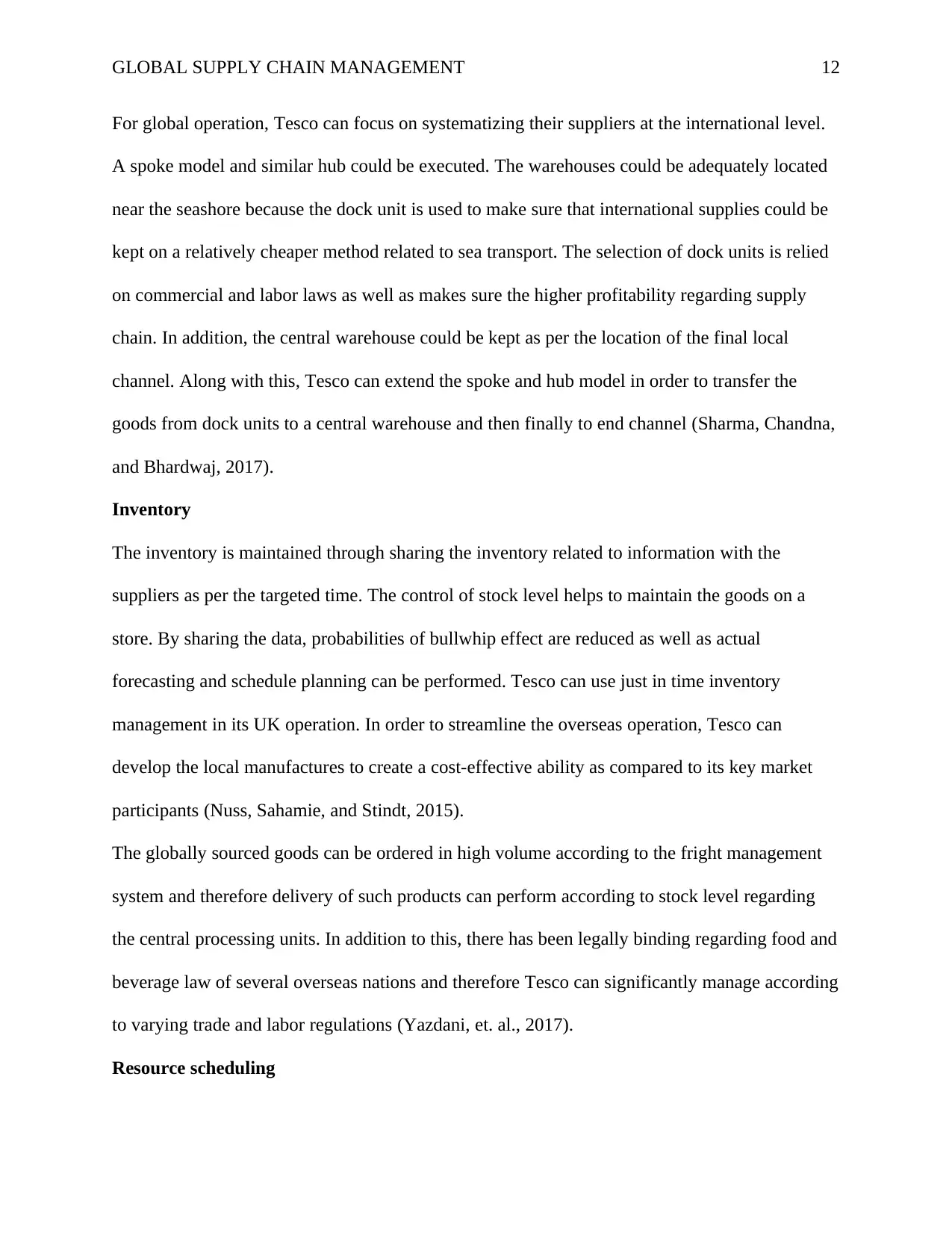
GLOBAL SUPPLY CHAIN MANAGEMENT 12
For global operation, Tesco can focus on systematizing their suppliers at the international level.
A spoke model and similar hub could be executed. The warehouses could be adequately located
near the seashore because the dock unit is used to make sure that international supplies could be
kept on a relatively cheaper method related to sea transport. The selection of dock units is relied
on commercial and labor laws as well as makes sure the higher profitability regarding supply
chain. In addition, the central warehouse could be kept as per the location of the final local
channel. Along with this, Tesco can extend the spoke and hub model in order to transfer the
goods from dock units to a central warehouse and then finally to end channel (Sharma, Chandna,
and Bhardwaj, 2017).
Inventory
The inventory is maintained through sharing the inventory related to information with the
suppliers as per the targeted time. The control of stock level helps to maintain the goods on a
store. By sharing the data, probabilities of bullwhip effect are reduced as well as actual
forecasting and schedule planning can be performed. Tesco can use just in time inventory
management in its UK operation. In order to streamline the overseas operation, Tesco can
develop the local manufactures to create a cost-effective ability as compared to its key market
participants (Nuss, Sahamie, and Stindt, 2015).
The globally sourced goods can be ordered in high volume according to the fright management
system and therefore delivery of such products can perform according to stock level regarding
the central processing units. In addition to this, there has been legally binding regarding food and
beverage law of several overseas nations and therefore Tesco can significantly manage according
to varying trade and labor regulations (Yazdani, et. al., 2017).
Resource scheduling
For global operation, Tesco can focus on systematizing their suppliers at the international level.
A spoke model and similar hub could be executed. The warehouses could be adequately located
near the seashore because the dock unit is used to make sure that international supplies could be
kept on a relatively cheaper method related to sea transport. The selection of dock units is relied
on commercial and labor laws as well as makes sure the higher profitability regarding supply
chain. In addition, the central warehouse could be kept as per the location of the final local
channel. Along with this, Tesco can extend the spoke and hub model in order to transfer the
goods from dock units to a central warehouse and then finally to end channel (Sharma, Chandna,
and Bhardwaj, 2017).
Inventory
The inventory is maintained through sharing the inventory related to information with the
suppliers as per the targeted time. The control of stock level helps to maintain the goods on a
store. By sharing the data, probabilities of bullwhip effect are reduced as well as actual
forecasting and schedule planning can be performed. Tesco can use just in time inventory
management in its UK operation. In order to streamline the overseas operation, Tesco can
develop the local manufactures to create a cost-effective ability as compared to its key market
participants (Nuss, Sahamie, and Stindt, 2015).
The globally sourced goods can be ordered in high volume according to the fright management
system and therefore delivery of such products can perform according to stock level regarding
the central processing units. In addition to this, there has been legally binding regarding food and
beverage law of several overseas nations and therefore Tesco can significantly manage according
to varying trade and labor regulations (Yazdani, et. al., 2017).
Resource scheduling
⊘ This is a preview!⊘
Do you want full access?
Subscribe today to unlock all pages.

Trusted by 1+ million students worldwide
1 out of 21
Related Documents
Your All-in-One AI-Powered Toolkit for Academic Success.
+13062052269
info@desklib.com
Available 24*7 on WhatsApp / Email
![[object Object]](/_next/static/media/star-bottom.7253800d.svg)
Unlock your academic potential
Copyright © 2020–2025 A2Z Services. All Rights Reserved. Developed and managed by ZUCOL.





